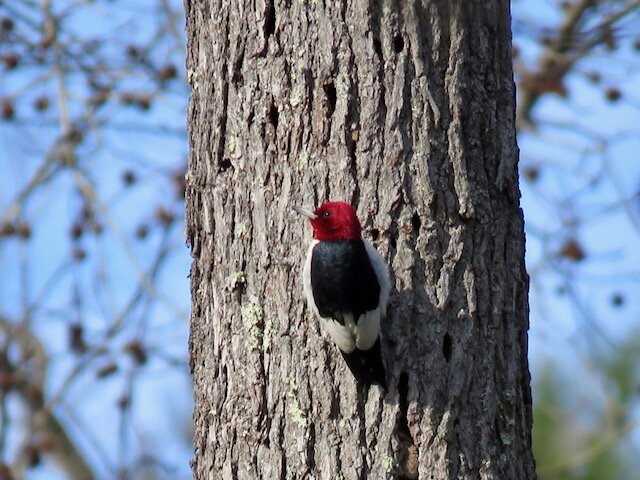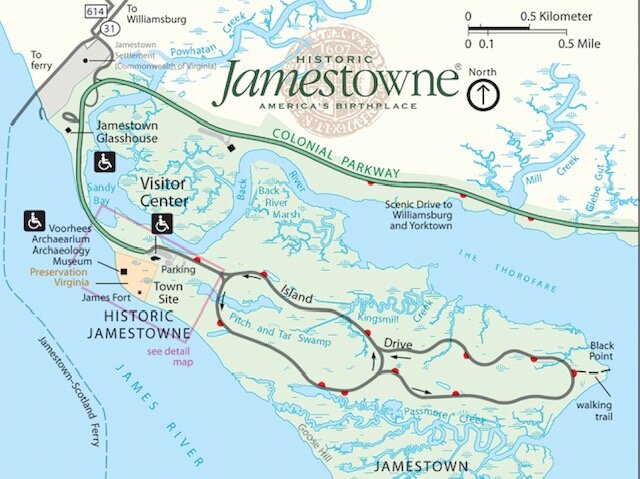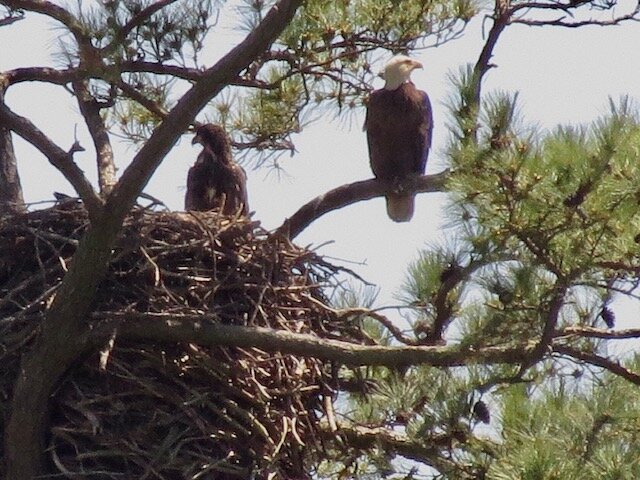Jamestown Island, a favorite among local birders, is a low-lying island jutting into the James River. The island, owned by the National Park Service, has a 5-mile loop road which can be driven, walked, or bicycled. The eleven pull-offs provide excellent birding opportunities as well as historical wayside markers describing the extensive human history of the island. With a range of habitats including southern mixed hardwood forest, interior hardwood swamp, tidal salt marsh, riverfront and the open water of the James River, expect an impressive array of permanent residents as well as migrants and summer breeders. Well known for the local population of Red-headed Woodpeckers and Brown-headed Nuthatches this Hotspot has over 215 species recorded on eBird.
Over 300 pairs of Bald Eagles nest along the James River, and Jamestown Island has its share. Watch for adult and immature Bald Eagles at any time of year. By late winter Osprey begin to return for the breeding season and can be seen in numerous locations. Great Horned, Barred, and Eastern Screech-Owls are permanent residents and the lucky visitor can catch a glimpse of these birds anywhere on the island. Winter viewing of owls is often the best as bare trees provide good looks at these birds roosting in warm sunny spots. Turkey and Black Vultures are regular sights at any time.
With plenty of snags, oaks, and Loblolly pines, Jamestown Island is home to the six species of resident woodpeckers and Yellow- bellied Sapsuckers in the winter. Red-headed Woodpeckers can be seen in multiple locations but the best spot to find this local permanent resident is in the semi-open wooded area just before Black Point.
As you cross any of the wooden bridges over the marshes in the spring and summer you are likely to see dozens of Barn Swallows which nest under the bridges. Other aerial birds you are likely to see include Tree Swallows, Chimney Swifts and occasionally Purple Martins.
Passerines are plentiful on Jamestown Island. The spring months of March, April, and May produce the largest number of species. Watch for warblers including Pine, Yellow-throated, Common Yellowthroat, Black-and-white, Palm, Northern Parula, Ovenbird, Yellow Warbler, Prairie and Hooded, among others. By June and July the breeders predominate; Summer Tanager, Orchard Oriole, Indigo Bunting, Blue Grosbeak, Red-eyed Vireo, Eastern Kingbird, Acadian Flycatcher, Great-crested Flycatcher, Blue-gray Gnatcatcher, and Yellow-billed Cuckoo to name a few. In fall migration additional warbler species can be found including Cape May and Blue-winged. By winter the kinglets, Yellow-rumped Warblers, Brown Creepers, Hermit Thrush and Winter Wrens take center stage, along with White-throated, Swamp, and Fox Sparrows. Watch for large flocks of Cedar Waxwings and American Robins gorging on American Holly berries, particularly in the area around “The Traverse Estate” pull-off.
A small parking area at Black Point, the farthest end of the island, gives access to a short trail out to the James River. In the winter, ducks including Greater and Lesser Scaup, Red-breasted Merganser, and Bufflehead can be abundant. Double-crested Cormorants and occasional Brown Pelicans can be seen up and down the river. Several small areas of interior water around the island can produce Wood Duck, American Black Duck, Hooded Merganser, Green- winged Teal, and Mallard. Infrequent visitors have included Northern Pintail and Ring-necked Duck. At low tide, exposed mudflats in the tidal creeks can attract Greater and Lesser Yellowlegs, and Spotted Sandpipers. Despite extensive marsh, rails are uncommon; Virginia Rail, Clapper Rail and Sora are possible, often heard rather than seen. Great Blue Heron, terns, gulls, and Belted Kingfisher are common sights.
Accessibility: Historic Jamestowne entrance gate hours are 8:30 am. - 4:30 p.m. daily except Thanksgiving Day, Christmas, and New Years Day. Beyond the gate you will be in a fee area. Fees are collected in the Visitor Center or you can use a National Park Pass. The 5-mile Island Loop road starts approximately one mile past the entrance gate. Consider staying to visit the historic site after birding. Note: The historic site is a National Park Service and Preservation Virginia fee area.
Owner/Manager: National Park Service
eBird Hotspot: Jamestown Island
—Nancy Barnhart



